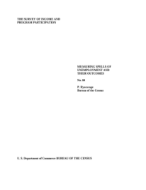Measuring Spells of Unemployment and Their Outcomes
Measuring Spells of Unemployment and Their Outcomes
Conclusions
This paper has discussed and demonstrated the applicability of SIPP data for the analysis of issues relating to unemployment duration and the well-being of unemployed persons. The focal point of the paper was the large number of unemployment spells beginning in 1984 and 1985 (and eventually completed) that were monitored through SIPP interviews. Three conclusions emerge from the paper.
1. The unemployment information collected in SIPP is a source of data that could be used in conjunction with analyses that have been based on CPS unemployment data. Not only could SIPP continuation rates, or the probabilities of remaining unemployed, be compared to those derived from the CPS, but other labor force transitions could be observed to study the dynamic relationships between labor force "stocks" and "flows."
2. Although SIPP's sample size is small relative to the CPS, its fully longitudinal design and broad subject coverage makes it an attractive data source for addressing issues relating to the well-being of unemployed persons. Some of the findings from a descriptive analysis of unemployment spells that began in 1984 and were completed are:
-- the average length of a completed spell of unemployment (limited definition) was 3.46 months, or 14.9 weeks;
-- more women than men began unemployment spells;
-- men were more likely than women to end a spell of unemployment by finding a job;
-- about 20 percent of the persons who had health insurance coverage before a spell (both definitions) either lost their coverage or had only partial coverage during the spell;
-- and in less than 20 percent of the spells (,both definitions) begun in 1984, unemployment insurance benefits were received.
3. The labor force information obtained through SIPP has limitations as does all survey data. More research is required to understand these limitations.
Others in Series
Working Paper
Working Paper
Working Paper




